1. Hello everyone, yesterday Ch 6 of the #Caliphate podcast went live, detailing how we fact-checked Abu Huzayfah's story. At least 15 @nytimes reporters, stringers and translators worked to bring you that one episode. Follow along for the back story: itunes.apple.com/us/podcast/cal…
2. By now, you've heard the detailed account of murder by one Canadian member of ISIS. As many of you have asked, why in the world would this young man admit to such crimes in an interview with the @nytimes? I'm finally able to reveal that we began speaking to him 1.5 yrs ago
3. @AndyMillsNYT & I first learned of Abu Huzayfah in November 2016. He had left Syria over a year before that & had successfully traveled back and forth to Canada and his grandparent's home in Pakistan. Because no one stopped him at the airport, he assumed he was in the clear
4. We were the first people outside his family to speak to him about his experience - and we interviewed him in person before police, and nearly a year before other media. He told us he wanted closure. Not even 12 hrs after he left our hotel, CSIS came and banged on his door.
5. We kept in touch with him over the next year-and-a-half and flew back to Canada to interview him on two other occasions. We also spoke to him by phone. I continue to speak to him now. In that time, everything changed for him. CSIS & RCMP interrogated him. He began to panic.
6. He began sending me increasingly anxious texts asking us to drop the podcast. I told him we couldn't. At one point, he offered via an intermediary to pay us money to drop the podcast (of course we would *never* accept money from a source for any reason, so I again told him no)
7. Then as we neared publication, he began to say that if we went ahead and published, he would call it "fake news" and say he made it up. That's exactly what he has done. So now let me lay out for you what we know to be true about his account.
8. First, I reached out to my colleague @nixonron, who covers Homeland Security. He determined that Huzayfah had been placed on the United States' no-fly list. That means he can't board an American carrier. In addition, he also can't enter American airspace.
9. So imagine Huzayfah wanted to take an Air Canada flight from Toronto to Paris, and the flight cuts across Buffalo, N.Y. - then he can't board that flight b/c it enters American airspace. @nixonron explained to me that this is a big deal.
10. Next, I reached out to @EricSchmittNYT & @adamgoldmanNYT. I've known these reporters for years & they are among the best-sourced journalists in our business. They called several different intelligence/government agencies. They were told Huzayfah was an ex-member of ISIS
11. They were also told that he joined ISIS in Syria. One official gave a plausible timeline of 2014 to early 2015. Huzayfah had told us that he'd gone to Syria in Feb 2014 and left before the caliphate was declared on July 4, 2014. So far so good, right? Things were lining up
12. But during our interview, Huzayfah had also said a # of things that contradicted that timeline. Here are some of the inconsistencies: (1) He said he left pre-caliphate. But he also said he remembered candy being handed out the day Baghdadi announced the caliphate
13. By his original account, he left before July 4, 2014. But he also said he remembered the Yazidi girls being brought in trucks to Syria. The Yazidi women and girls were kidnapped on Sinjar mountain starting Aug. 3, 2014 and began being transported to Syria end of August 2014
14. We at @nytimes never take people at face value and so to factcheck his account, I asked him to show me his passport. He was kind enough to let me take pictures of it. It was when I began carefully studying the stamps that my team & I noticed this July 1, 2014 exit stamp: 
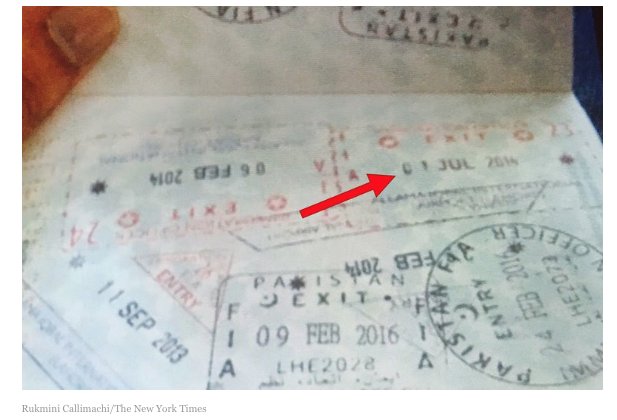
15. Could that July 1 exit stamp be an exit out of Turkey? That would line up with Huzayfah's account. We then turned to my ingenious colleague @salmanmasood in Islamabad, who was able to use Huzayfah's passport number to get his detailed travel log in and out of Pakistan.
16. That July 1 stamp? It was an exit out of Lahore as he boarded a flight to Canada. We also saw that in February 2014 - the date he said he arrived in Syria - he was flying back & forth between Canada and Pakistan. At this point, it was obvious he had lied to us about the dates 

17. Also on this travel log, we noticed there was a multi-month gap from 9/2014 to 4/2015 when he was not traveling. Could that have been when he went to Syria? If he went in the fall of 2014, the Yazidi example would make sense. That's when we began to fixate on this picture 
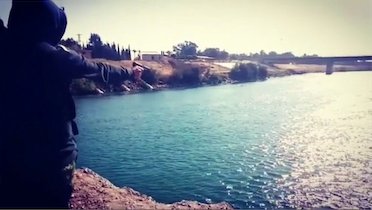
18. This is a still from a video Huzayfah shared with me. He said it shows him shooting a glock into the Euphrates River in Syria. He has given me permission to post it (likely because you can't make out his face). That's when we turned to my talented colleague @malachybrowne
19. @malachybrowne is an expert on geolocation. He's able to take nondescript images like the one below & zoom in on tiny geographic features that and use them to find the exact GPS location of where the image was taken. Below are the features that Malachy studied: 
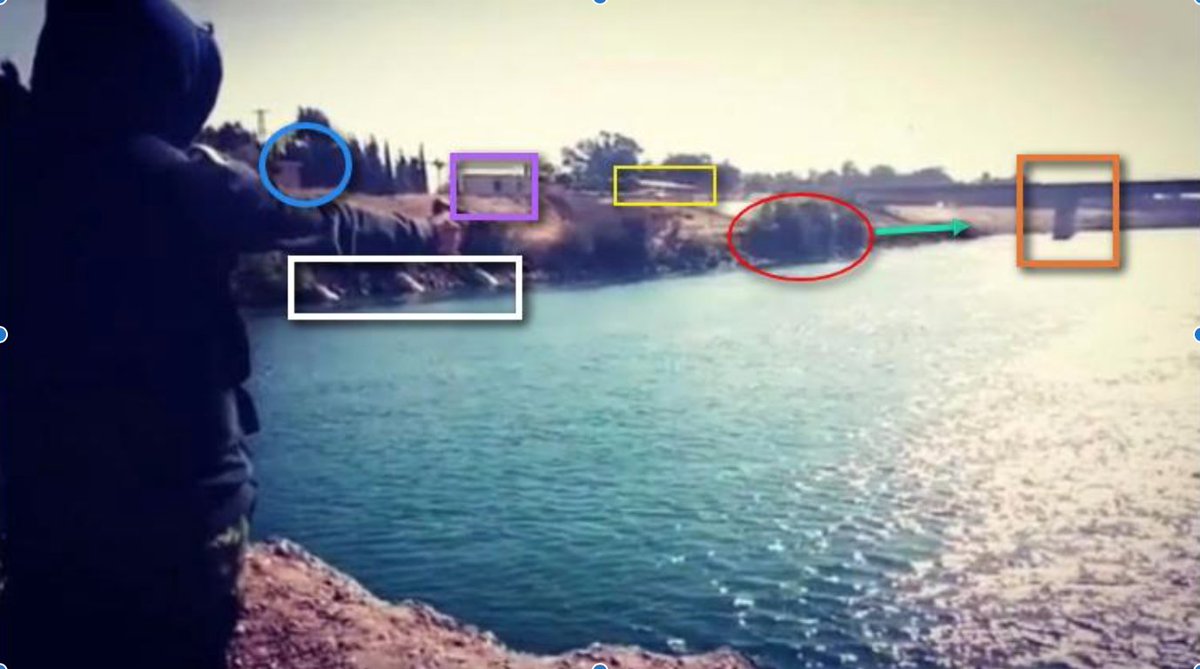
20. (Intermission is starting now. My crack podcast team of @larissaluu @AndyMillsNYT @SchwendyDorr @Pasthaaa are waiting for me in the studio to record future episodes of #Caliphate. Back with you in a few hours).
21. Welcome back, everyone. Continuing where we left off, we now know that Huzayfah for sure lied about the timeline of when he went to Syria. But can we prove when he went? The picture below provided one more data point. Check out the structures circled by @malachybrowne: 

22. The still from the video showing a man aiming a pistol over a body of water shows a bridge, a small house, some trees & a pumping system. Huzayfah claimed this photo was shot near Membij. It wasn't. @malachybrowne spent a day travelling up and down the Euphrates River online
23. He finally found the exact place where this photo was taken. The GPS location is 35.928191, 38.994816. Here is the pin: google.com/maps/place/35°55'41.5%22N+38°59'41.3%22E/@35.9281944,38.9926169,1453m/data=!3m1!1e3!4m5!3m4!1s0x0:0x0!8m2!3d35.9281944!4d38.9948056
24. The only spot that matched that exact angle to the bridge & the composition of buildings & shrubs was in a bend of the Euphrates near Raqqa. And for the angle to be replicated like it was in the picture, the shooter had to be standing on an island inside the river: 

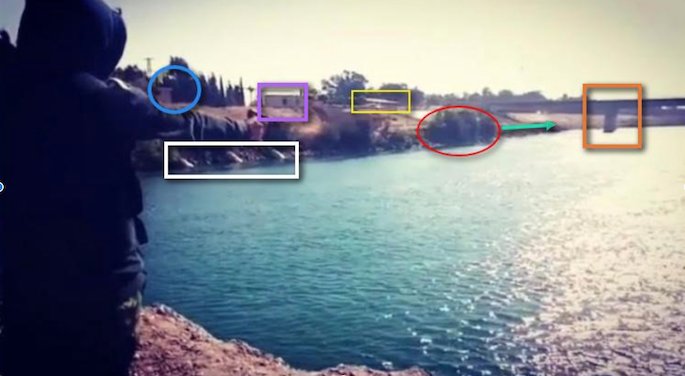
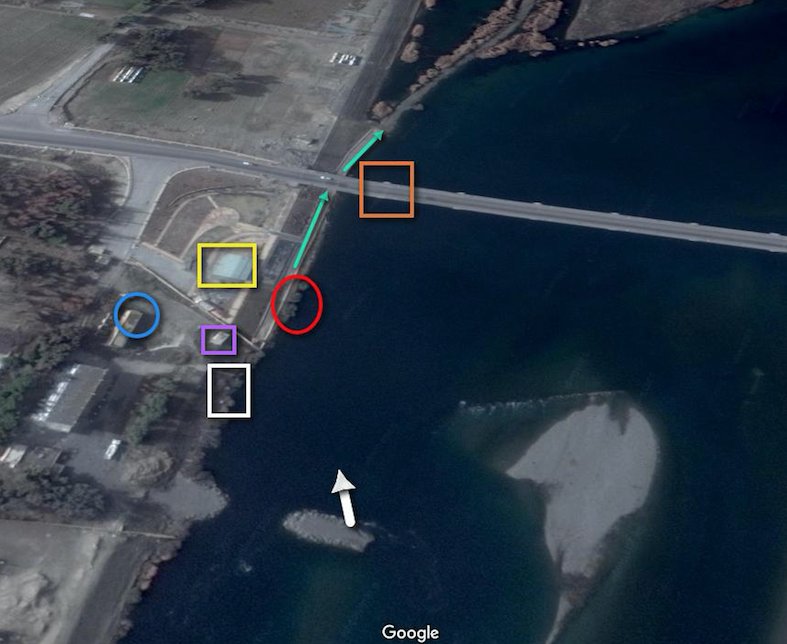
25. Now here is where it gets interesting: In satellite images you can see that the island inside that bend in the river did *not* exist in Nov 2014 (first picture). It's clearly visible by spring 2015 (second image). @malachybrowne here got an assist from @ckoettl & @planetlabs 

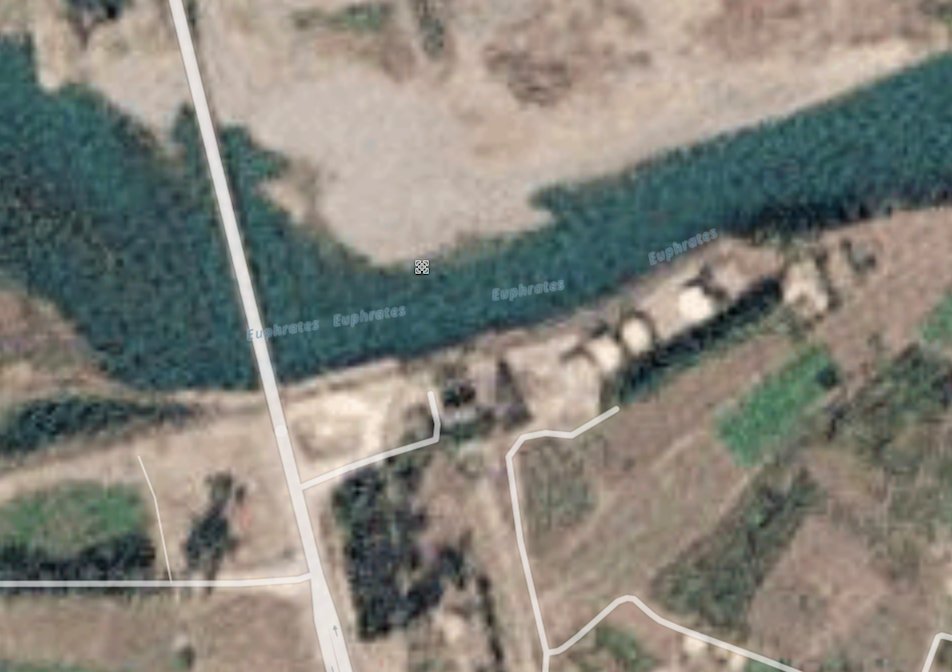
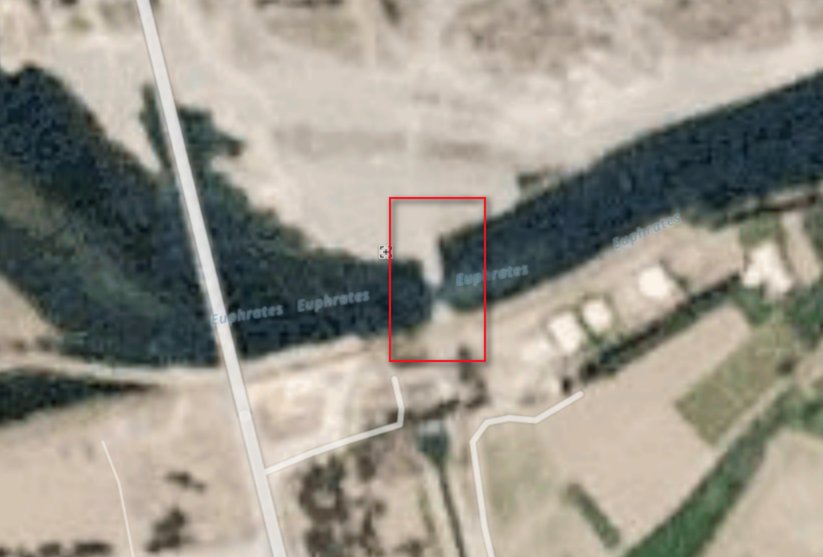
26. @malachybrowne believes the island in the river is a man-made gravel pile of some kind. But if the man shooting in that image is indeed Huzayfah, he can't have taken that shot pre-November 2014. (Again it points to a later timeline).
26. Finally, in the Canadian passport that Huzayfah showed me there's no entry stamp for Turkey. When I confronted him on this point, he said he used his Pakistani passport. @salmanmasood in Islamabad was able to pull up that passport and it's been expired for years.
27. Next @salmanmasood visited the campus of Huzayfah's university in Pakistan. His transcript shows he was getting grades through fall 2014, but there's a gap from Jan-March 2015. We found a doc showing he'd dropped out of the winter semester (it's cropped to remove his name) 

28. So at this point here is what we know: The window of time that he could have gone to Syria has shrunk from most likely Jan-March 2015 (unless he had someone posing for him in classes in the fall of 20140. He didn't use his Canadian or his Pakistani passport to get in.
29. At this point, we called to let him know what we knew. He got quiet & he finally admitted that he'd lied about the timeline. He said he thought it would look more innocent if he'd gone pre-caliphate. But on which passport?
30. I'd begun to suspect that he used either a fraudulent passport or borrowed one from a friend or relative. He did not want to discuss this point, and I don't blame him. I realized then the conundrum authorities find themselves in.
31. If he's managed to hide the travel document he used to go to Turkey and then Syria, it means RCMP can't even prove he entered Turkey, much less Syria (where there is no stamp). Thank you to all of you who followed along. The link to the episode is here itunes.apple.com/us/podcast/cal…
• • •
Missing some Tweet in this thread? You can try to
force a refresh













